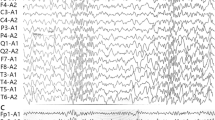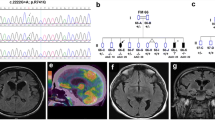Abstract
Dystonias are a clinically and genetically heterogeneous group of movement disorders characterized by involuntary, sustained muscular contractions affecting one or more sites of the body, and abnormal postures. In this study, we describe an autosomal recessive family that presents with a progressive and early-onset form of generalized dystonia. The nuclear family consists of two healthy parents and two affected daughters. To elucidate the genetic causes underlying disease, whole-exome sequencing analysis was performed in one affected sibling, followed by validation, biochemical analyses and MRI brain imaging. A homozygous, disease-segregating mutation (p.Val400Met) was identified in the glutaryl-CoA dehydrogenase (GCDH) gene at chromosome 19p13. The mutation, in an amino acid that is highly conserved among species, was absent in large number of neurologically normal individuals. Biochemical analyses demonstrated increased 3-hydroxy glutaric acid present in urine samples from both patients. MRI imaging revealed a T2 and flair hyperintense signal in lenticular nuclei with bilateral and symmetrical distribution. We conclude that both GCDH activity and GCDH mutation analysis should be considered in the differential diagnosis of progressive forms of early-onset generalized dystonia and that mitochondrial fatty acid metabolism is one important pathway in the development of dystonia. As lysine restriction and l-carnitine supplementation are important treatments for GCDH deficiency, identification of this deficiency in patients with progressive forms of early-onset generalized dystonia has potential treatment implications.



Similar content being viewed by others
References
Baric I, Zschocke J, Christensen E, Duran M, Goodman SI, Leonard JV, Muller E, Morton DH, Superti-Furga A, Hoffmann GF (1998) Diagnosis and management of glutaric aciduria type I. J Inherit Metab Dis 21:326–340
Berardelli A, Thompson PD, Zaccagnini M, Giardini O, D’Eufemia P, Massoud R, Manfredi M (1991) Two sisters with generalized dystonia associated with homocystinuria. Mov Disord 6:163–165
Biery BJ, Stein DE, Morton DH, Goodman SI (1996) Gene structure and mutations of glutaryl-coenzyme A dehydrogenase: impaired association of enzyme subunits that is due to an A421V substitution causes glutaric acidemia type I in the Amish. Am J Hum Genet 59:1006–1011
Bilguvar K, Ozturk AK, Louvi A, Kwan KY, Choi M, Tatli B, Yalnizoglu D, Tuysuz B, Caglayan AO, Gokben S, Kaymakcalan H, Barak T, Bakircioglu M, Yasuno K, Ho W, Sanders S, Zhu Y, Yilmaz S, Dincer A, Johnson MH, Bronen RA, Kocer N, Per H, Mane S, Pamir MN, Yalcinkaya C, Kumandas S, Topcu M, Ozmen M, Sestan N, Lifton RP, State MW, Gunel M (2010) Whole-exome sequencing identifies recessive WDR62 mutations in severe brain malformations. Nature 467:207–210
Bressman SB (2007) Genetics of dystonia: an overview. Parkinsonism Relat Disord 13(Suppl 3):S347–S355
Busquets C, Merinero B, Christensen E, Gelpi JL, Campistol J, Pineda M, Fernandez-Alvarez E, Prats JM, Sans A, Arteaga R, Marti M, Campos J, Martinez-Pardo M, Martinez-Bermejo A, Ruiz-Falco ML, Vaquerizo J, Orozco M, Ugarte M, Coll MJ, Ribes A (2000) Glutaryl-CoA dehydrogenase deficiency in Spain: evidence of two groups of patients, genetically, and biochemically distinct. Pediatr Res 48:315–322
Camargos S, Scholz S, Simon-Sanchez J, Paisan-Ruiz C, Lewis P, Hernandez D, Ding J, Gibbs JR, Cookson MR, Bras J, Guerreiro R, Oliveira CR, Lees A, Hardy J, Cardoso F, Singleton AB (2008) DYT16, a novel young-onset dystonia-parkinsonism disorder: identification of a segregating mutation in the stress-response protein PRKRA. Lancet Neurol 7:207–215
de Carvalho Aguiar PM, Ozelius LJ (2002) Classification and genetics of dystonia. Lancet Neurol 1:316–325
Depristo MA, Banks E, Poplin R, Garimella KV, Maguire JR, Hartl C, Philippakis AA, Del Angel G, Rivas MA, Hanna M, McKenna A, Fennell TJ, Kernytsky AM, Sivachenko AY, Cibulskis K, Gabriel SB, Altshuler D, Daly MJ (2011) A framework for variation discovery and genotyping using next-generation DNA sequencing data. Nat Genet 43:491–498
Dick KJ, Eckhardt M, Paisan-Ruiz C, Alshehhi AA, Proukakis C, Sibtain NA, Maier H, Sharifi R, Patton MA, Bashir W, Koul R, Raeburn S, Gieselmann V, Houlden H, Crosby AH (2010) Mutation of FA2H underlies a complicated form of hereditary spastic paraplegia (SPG35). Hum Mutat 31:E1251–E1260
Edvardson S, Hama H, Shaag A, Gomori JM, Berger I, Soffer D, Korman SH, Taustein I, Saada A, Elpeleg O (2008) Mutations in the fatty acid 2-hydroxylase gene are associated with leukodystrophy with spastic paraparesis and dystonia. Am J Hum Genet 83:643–648
Elia AE, Lalli S, Albanese A (2010) Differential diagnosis of dystonia. Eur J Neurol 17(Suppl 1):1–8
Fuchs T, Gavarini S, Saunders-Pullman R, Raymond D, Ehrlich ME, Bressman SB, Ozelius LJ (2009) Mutations in the THAP1 gene are responsible for DYT6 primary torsion dystonia. Nat Genet 41:286–288
Gascon GG, Ozand PT, Brismar J (1994) Movement disorders in childhood organic acidurias. Clinical, neuroimaging, and biochemical correlations. Brain Dev 16(Suppl):94–103
Horvath GA, Stockler-Ipsiroglu SG, Salvarinova-Zivkovic R, Lillquist YP, Connolly M, Hyland K, Blau N, Rupar T, Waters PJ (2008) Autosomal recessive GTP cyclohydrolase I deficiency without hyperphenylalaninemia: evidence of a phenotypic continuum between dominant and recessive forms. Mol Genet Metab 94:127–131
Ichinose H, Ohye T, Takahashi E, Seki N, Hori T, Segawa M, Nomura Y, Endo K, Tanaka H, Tsuji S et al (1994) Hereditary progressive dystonia with marked diurnal fluctuation caused by mutations in the GTP cyclohydrolase I gene. Nat Genet 8:236–242
Kruer MC, Paisan-Ruiz C, Boddaert N, Yoon MY, Hama H, Gregory A, Malandrini A, Woltjer RL, Munnich A, Gobin S, Polster BJ, Palmeri S, Edvardson S, Hardy J, Houlden H, Hayflick SJ (2010) Defective FA2H leads to a novel form of neurodegeneration with brain iron accumulation (NBIA). Ann Neurol 68:611–618
Li H, Durbin R (2009) Fast and accurate short read alignment with Burrows-Wheeler transform. Bioinformatics 25:1754–1760
Li H, Handsaker B, Wysoker A, Fennell T, Ruan J, Homer N, Marth G, Abecasis G, Durbin R (2009) The Sequence Alignment/Map format and SAMtools. Bioinformatics 25:2078–2079
Makarov V, O’Grady T, Cai G, Lihm Y, Buxbaum JD, Seungtai Y (2011) AnnTools: comprehensive and versatile annotation toolkit for genomic variants. BMC Bioinformatics (submitted)
McKenna A, Hanna M, Banks E, Sivachenko A, Cibulskis K, Kernytsky A, Garimella K, Altshuler D, Gabriel S, Daly M, DePristo MA (2010) The Genome Analysis Toolkit: a MapReduce framework for analyzing next-generation DNA sequencing data. Genome Res 20:1297–1303
Muller U (2009) The monogenic primary dystonias. Brain 132:2005–2025
Mushimoto Y, Fukuda S, Hasegawa Y, Kobayashi H, Purevsuren J, Li H, Taketani T, Yamaguchi S (2011) Clinical and molecular investigation of 19 Japanese cases of glutaric acidemia type 1. Mol Genet Metab 102:343–348
Ozelius LJ, Hewett JW, Page CE, Bressman SB, Kramer PL, Shalish C, de Leon D, Brin MF, Raymond D, Corey DP, Fahn S, Risch NJ, Buckler AJ, Gusella JF, Breakefield XO (1997) The early-onset torsion dystonia gene (DYT1) encodes an ATP-binding protein. Nat Genet 17:40–48
Perez-Duenas B, De La Osa A, Capdevila A, Navarro-Sastre A, Leist A, Ribes A, Garcia-Cazorla A, Serrano M, Pineda M, Campistol J (2009) Brain injury in glutaric aciduria type I: the value of functional techniques in magnetic resonance imaging. Eur J Paediatr Neurol 13:534–540
Thony B, Blau N (2006) Mutations in the BH4-metabolizing genes GTP cyclohydrolase I, 6-pyruvoyl-tetrahydropterin synthase, sepiapterin reductase, carbinolamine-4a-dehydratase, and dihydropteridine reductase. Hum Mutat 27:870–878
Tolosa E, Compta Y (2006) Dystonia in Parkinson’s disease. J Neurol 253(Suppl 7):VII7–VII13
Tortorelli S, Hahn SH, Cowan TM, Brewster TG, Rinaldo P, Matern D (2005) The urinary excretion of glutarylcarnitine is an informative tool in the biochemical diagnosis of glutaric acidemia type I. Mol Genet Metab 84:137–143
Wider C, Melquist S, Hauf M, Solida A, Cobb SA, Kachergus JM, Gass J, Coon KD, Baker M, Cannon A, Stephan DA, Schorderet DF, Ghika J, Burkhard PR, Kapatos G, Hutton M, Farrer MJ, Wszolek ZK, Vingerhoets FJ (2008) Study of a Swiss dopa-responsive dystonia family with a deletion in GCH1: redefining DYT14 as DYT5. Neurology 70:1377–1383
Acknowledgments
We would like to thank the patients and their family for their contribution to this study, and Mihaela Gazdoiu for technical advice. The Dystonia Medical Research Foundation supported this work (DMRF; C.P.-R.). The Department of Neurology, the Friedman Brain Institute and the Child Health and Development Institute at the Mount Sinai School of Medicine also support C.P.-R.
Conflict of interest
The authors declare they do not have any conflict of interest.
Author information
Authors and Affiliations
Corresponding author
Electronic supplementary material
Below is the link to the electronic supplementary material.
Rights and permissions
About this article
Cite this article
Marti-Masso, J.F., Ruiz-Martínez, J., Makarov, V. et al. Exome sequencing identifies GCDH (glutaryl-CoA dehydrogenase) mutations as a cause of a progressive form of early-onset generalized dystonia. Hum Genet 131, 435–442 (2012). https://doi.org/10.1007/s00439-011-1086-6
Received:
Accepted:
Published:
Issue Date:
DOI: https://doi.org/10.1007/s00439-011-1086-6




